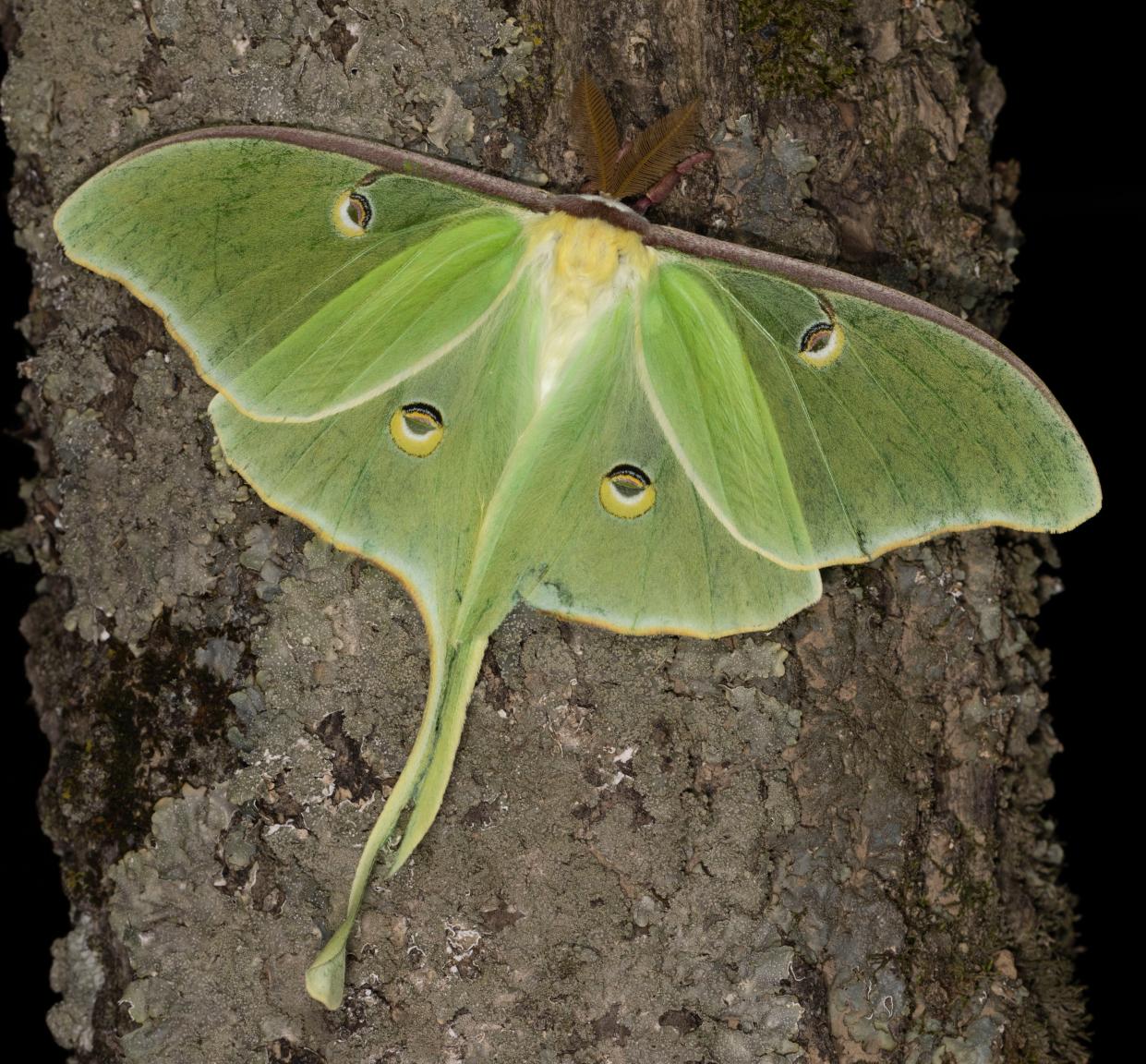Nature: Luna moths attract attention of many

"I have a little brown cocoon of an idea that may possibly expand into a magnificent moth of fulfilment," − Lucy Maud Montgomery
Moths, the lesser-known relatives of butterflies, represent one of the largest animal groups in Ohio. Butterflies, which fly during the day and are easily seen, are much better known than their nocturnal counterparts. About 140 butterfly species have been found in the state.
No one has a solid handle on the diversity of moths fluttering around the Buckeye State. The work of a remarkable woman named Diane Brooks opened a window into the incredible richness of moths in Ohio.
Brooks developed a passion for these fascinating insects about 11 years ago, and began seeking them out on her 12.5-acre Perry-County property. Since then, she has documented nearly 1,500 moth species, and regularly turns up even more new ones.
If there were a Diane Brooks in all 88 counties, Ohio’s moth list would number far higher, further dwarfing the butterfly tally. Who knows, there could be as many as 5,000 species, maybe more.
Many moths are obscure brown jobs, often tough to identify and virtually unnoticed by people. However, what they may lack in visual allure is often compensated by their names: disparaged arches, dusky owlet, figure-seven moth, scarce infant, sordid underwing and many other colorful monikers.
Nature: Northern long-eared bat facing extinction in Ohio due to flourishing fungus
The protagonist of this column needs little introduction. The luna moth is one of the world’s best-known moths. It has been used in various logos, many an artist has interpreted it and even the most neophyte moth-ers instantly recognize it.
While fairly common, at least where suitable habitat remains, the luna still attracts the attention of seasoned moth-ers. On Saturday, May 11, John Howard, Shauna Weyrauch and I were mothing at Howard's remote Adams-County property.
The brightly illuminated white sheet lured a variety of sphinx moths, honey locust moths, the splendid palpita, straight-lined pagodis and other interesting fare. However, when a luna appeared, it temporarily stole the show, as they always do. A photo of that moth accompanies this column.
This luna was a female, as evidenced by its narrow antennae. The male looks like two ferns have been bolted to its head. The broad, plumose antennae are packed with pheromone receptors capable of detecting the female’s scent from incredible distances. They can probably detect airborne pheromones from a mile away, maybe farther, and fly to her to consummate the relationship.

Part of the rub for a luna suitor is that he has to fly to her, and this brings bats into the equation. Moths are the primary prey for bats in our part of the world, and the fat fuzzy body of a luna is a fluttering T-bone steak. Enter the conspicuous tail streamers of the luna.
Bats use echolocation to detect flying prey, their sound waves bouncing off objects and reflecting back to the hunting bat. An organ called a tragus in the ears directs incoming echolocation clicks to the brain, which the bat instantaneously processes.
This bat sonar tells the bat exactly where the moth is. In the case of the luna, the bat’s echolocation system fixates on the tail, which shakes in flight. Thus, the bat often directs its attack to the tail streamers, allowing the luna to elude capture. It isn’t unusual to find lunas that are missing all or parts of the tail, but the moth lives to potentially reproduce.
Nature: Northern flickers are a sight to behold
The gorgeous lime-green luna with its dapper tails is the climax stage of a four-part life cycle. It starts life as a tiny egg, which hatches a caterpillar about 10 days later. While the caterpillar is miniscule fresh from the egg, it is an eating machine and quickly grows.
About seven weeks later, the now comparatively huge caterpillar enters pupation. Two or three weeks later, the pupa transforms into the iconic moth. In colder climes like Ohio, the pupae of the last brood over winter in cocoons in leaf litter.
Ironically, perhaps, the stunning moth, in the fourth part of the life cycle, is the briefest of the four phases. The adult moth lives perhaps a week. In essence, it is a flying gonad, living only to find a partner, mate and if the female, dump up to 400 eggs to start the cycle anew.
If you want to learn lots about moths, and see scores of them, including lunas, consider attending Mothapalooza. This moth-centric event takes place July 19-21 at Highlands Nature Sanctuary and is hosted by the Arc of Appalachia.
Details can be found at arcofappalachia.org/mothapalooza.
Naturalist Jim McCormac writes a column for The Dispatch on the first and third Sundays of the month. He also writes about nature at jim mccormac.blogspot.com.
This article originally appeared on The Columbus Dispatch: Luna moth is one of the best known in the world

